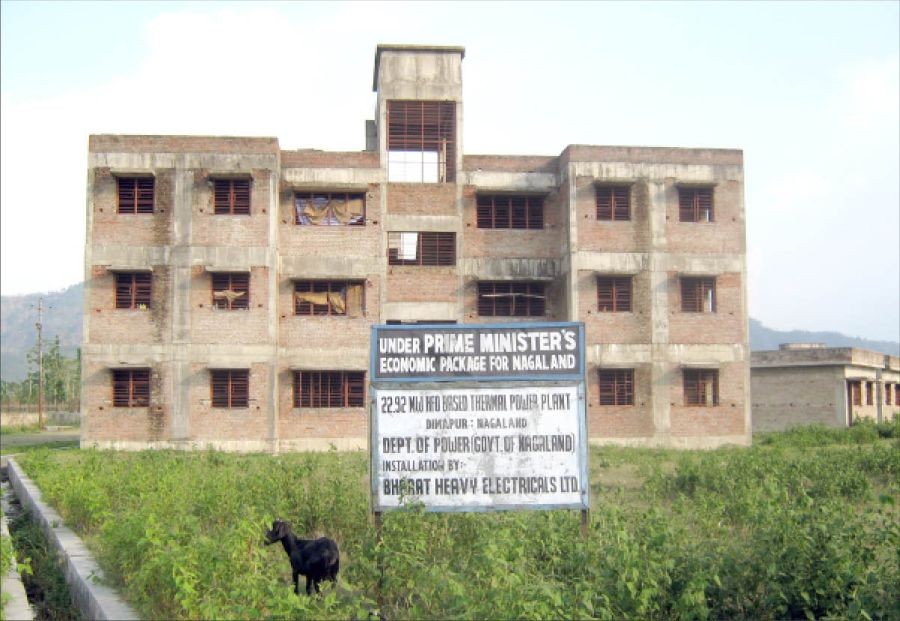A BAD SWITCH: The proposed BHEL thermal power plant of the state government lying in desolation at 7th Mile, Dimapur. About 12 RCC buildings, water tanks and structures meant for the supposed plant and two heavy machineries are lying in waste at the site. It is now being guarded by a few police personnel of the 6th NAP. (Morung Photo)

Energy-starved Nagaland in need of thermal power
Imkong Walling
Dimapur | May 21
Announced with much fanfare as part of the “special economic package,” the proposed heavy-fuel oil-based thermal power plant at Dimapur with a generating capacity of 22.92 MW of power is now lying stagnant. It may be mentioned that during October 2003 the then-Prime Minister AB Vajpayee during his visit here announced the project as part of the “special economic package” for the state. The projected cost of the plant was Rs 105.57 crores and scheduled to be completed by May 2005. However, this power project never came to see the light of day.
According to the Comptroller and Auditor General (CAG) of India report, the plant is lying in waste for the last two years. Also the condition of the machinery and equipment at the site of the plant is deteriorating due to non-maintenance and prolonged exposure to the elements. The CAG report further states that the records of the EE, Electrical Transmission Division of Dimapur shows the project was shut out by the department in May 2005. It also states ‘M\S BHEL handed over the project on “as is where is basis” to the department in July 2006’. What was supposed to be an income-generating venture has resulted in an unprofitable expenditure of Rs 32 crores.
To refresh public memory, in March 2004 one M\S Bharat Heavy Electricals Limited (BHEL), Bhopal was awarded the contract for the proposed plant. As such the DONER ministry, that was solicited to meet the fund requirements, released Rs 18.86 crore and Rs 13.14 crore in the months of March and August 2004 respectively.
With the sanction of the funds, plant construction and procurement of machinery and equipment was started in full swing. However, the report states that the DONER ministry refused to release the balance funding of Rs 73.57 crores for reasons best known to them. It also states that the state government was requested by the ministry to include the project in the priority list of the NLCPR (Non-Lapsable Central Pool of Resources) again “in order to give a fresh sanction”. The state government refused as the step would be compromising other projects.
Moreover, it was a “special economic package” of the PM’s. So the central government should be wholly responsible for the project the report supplemented.
It may be mentioned that over the years, experts having wide experience working in the state have suggested that the installation of a thermal power plant in Nagaland is of utmost necessity. To substantiate with a few statistics, more than 70% of power in India is generated through coal-fired thermal power plants. According to figures provided by the ministry of power the total installed capacity of power in India was 1, 24,287 megawatts during the year 2006. Of this total 68,518 megawatts of power were generated by coal-based thermal plants, while 32,326 megawatts were generated through hydro projects. Natural gas, diesel and nuclear energy accounted for 17,250 megawatts of power. Assuming by these figures it is found that nearly two thirds of the total energy requirement of the country is met by coal. Going by these figures, Nagaland having coal reserves in abundance can cure the problem of power shortage if this rich coal reserve is harnessed properly, provided the state has a thermal power plant, experts say.
Nagaland is supposed to be “100% electrified” if only on paper. “The dams have gone dry” is the same old argument put forward by the authorities in concern, year after year, to justify this “powerless” scenario. They have good reason to substantiate the claim owing to sparse or no rainfall at all in this part of the world at such time of season.
The maximum power requirement for the entire state during “peak hours” is about 100 megawatts and 45 megawatts during “off peak hours”. Now this is not that huge a demand compared with that of other states of the country. The two functional hydro electric dams of the state, 74 megawatts Doyang Hydro Electric Project (DHEP) and the 24 megawatts Likimro Hydro Electric Project (LHEP) combined generate just about enough electricity to meet power requirement for the entire state. However, the two projects being river-based cannot produce their maximum during dry seasons. This is the dilemma and many believe that Nagaland should be in a position to harness energy through thermal power plant.




.jpg)

